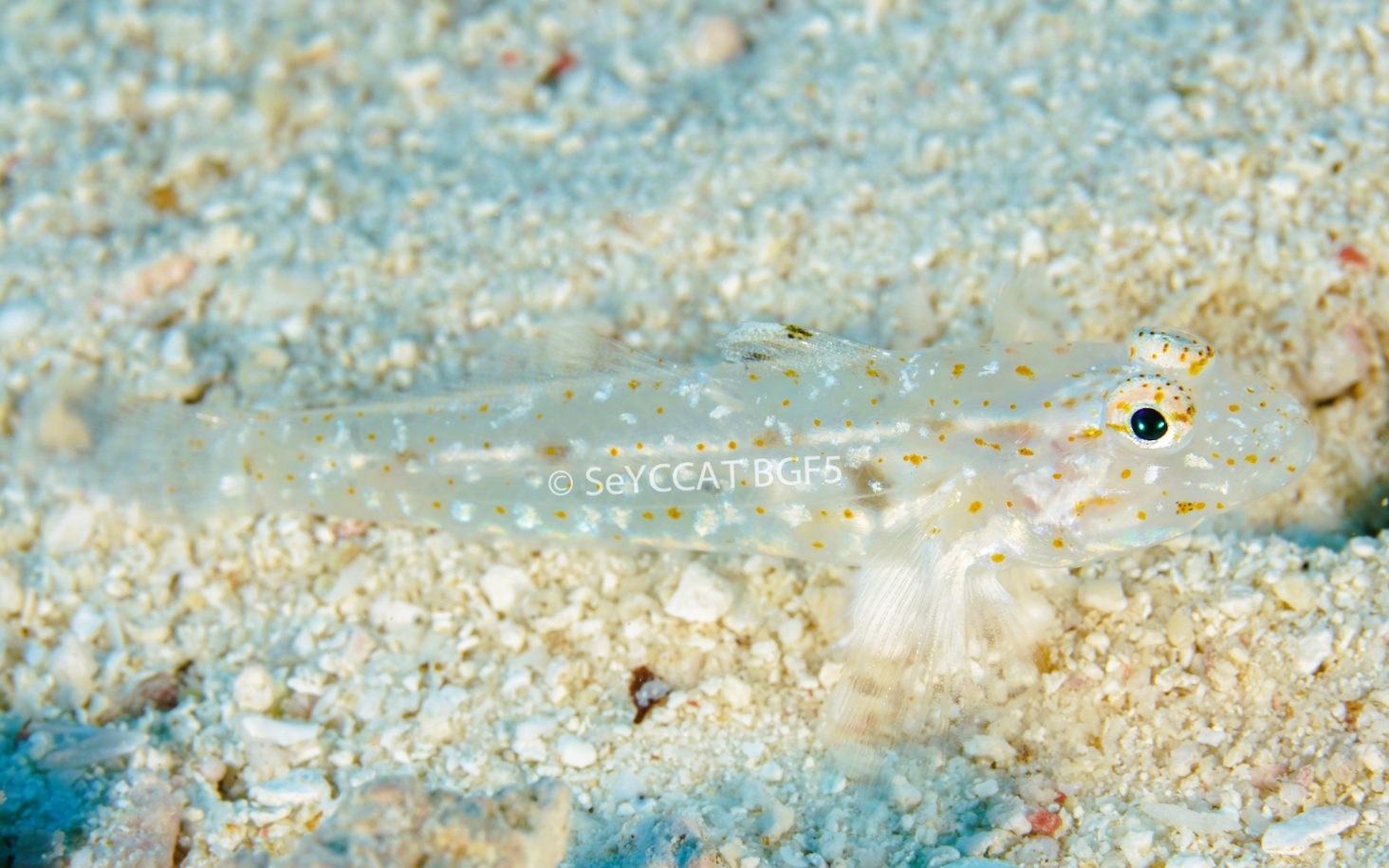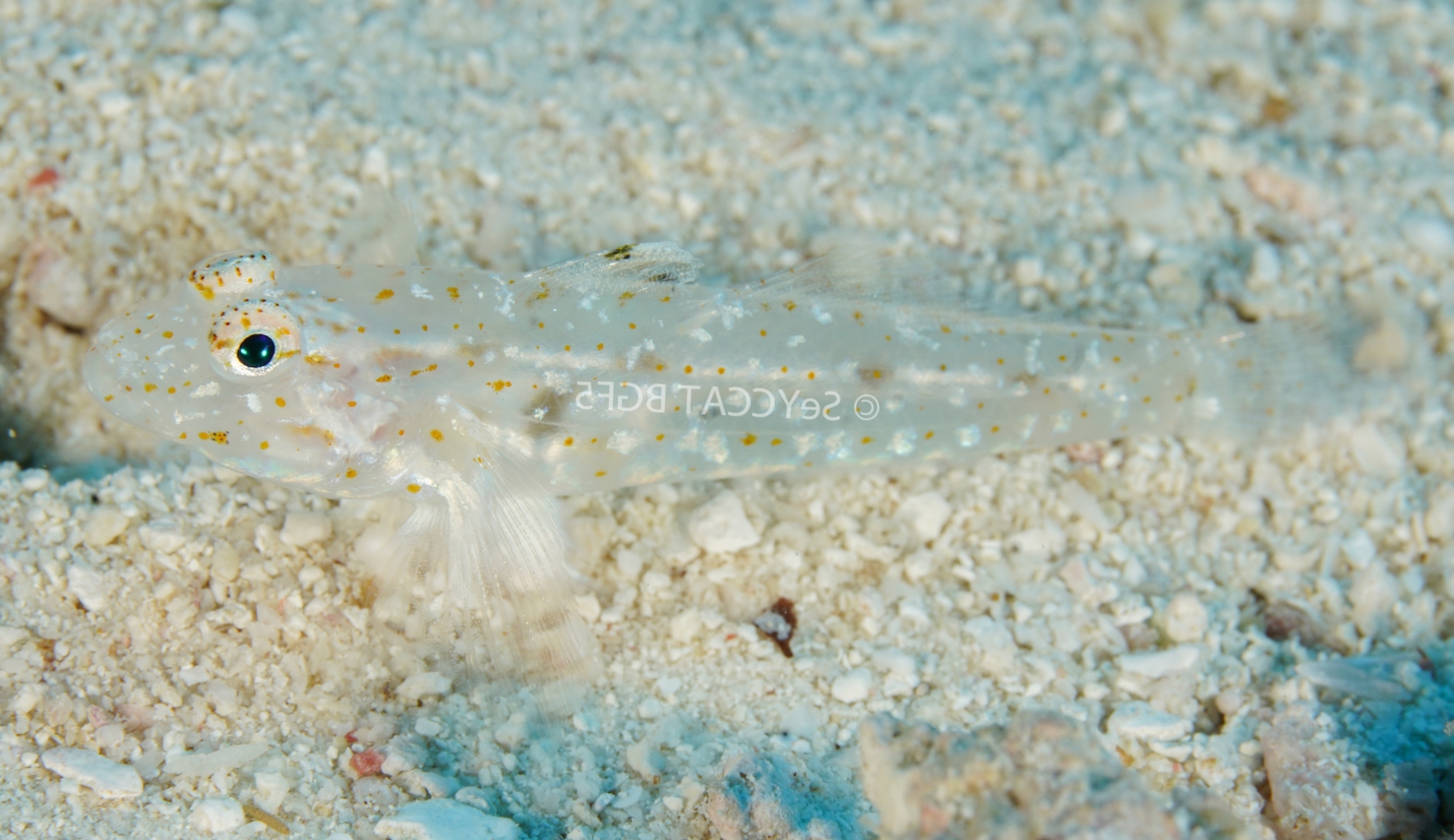Description:
Dorsal spines: 7; Dorsal rays: 9; Anal spines: 1; Anal rays: 8.
A small goby, body slender and compressed, tapering posteriorly. Head more or less triangular in cross-section. Snout short and pointed, mouth oblique.
Rear of jaws reach below front margin of pupil. Anterior nostril a short tube, just behind upper lip. Posterior nostril a pore closer to anterior nostril
than to eye. Opening of gill extending to or almost to vertical at posterior edge of opercle. Dorsal edge of eye little above dorsal profile of head.
Interorbital space very narrow and concave. First dorsal fin above pectoral fin base. First and second dorsal fins separated by a very short distance.
Pectoral fin long, extending to above second or third ray of anal fin. Pelvic fins connected to form a disc, thin membrane uniting them to or near to
tips of fifth rays. Caudal fin with a slightly rounded margin. Body covered with ctenoid scales. Prepelvic area and pectoral base covered with large
cycloid scales. Midline of nape naked. Sides of nape scaled forward to above posterior half of operculum or to above pectoral base. Cheek and operculum
without scales.
Colour. A semi-transparent greyish goby. Body with orange-brown spots and blotches. Two large black spots on first dorsal fin, anterior spot often
vertically elongate at tip of a thin black vertical line extending from base of fin, second spot between fifth and sixth dorsal spines; a faint black
spot above anterior margin of pectoral base; caudal peduncle with round to triangular spot; a thin vertical brown bar or oval blotch below eye.
Size:
Maturity: Uknown. Max length : 5.7 cm TL.
Habitat and Ecology:
Inhabits sandy floors of holes and depressions of clear seaward reefs (depth 1-46 m). Occurs singly or in groups, secretive. Benthic. Feeds on small
invertebrates.
Fishery Status:
This species is not protected or subject to fishery regulations.
Notes:
This species differs from other species of Fusigobius in pectoral ray and gill-raker counts, colouration, reduced pelvic frenum, branching of the pelvic
rays, presence of two large black spots on the first dorsal fin and shape of the first dorsal fin.
Photo courtesy Eleanor Brighton and Chris Mason-Parker (c) 2022 Blue Safari Seychelles/Marine Conservation Society, Seychelles.
Photograph taken at Alphonse group 2022.
References:
Bray, D.J. (2022). Fusigobius duospilus in Fishes of Australia, accessed 28 Nov 2023, https://fishesofaustralia.net.au/home/species/1372 (28/11/23)
Froese, R. & D. Pauly. Eds. (2023). FishBase. Fusigobius duospilus. https://fishbase.mnhn.fr/summary/Fusigobius-duospilus.html (28/11/23).
Hoese, D.F. & Reader, S. (1985). A new Gobiid fish, Fusiogobius duospilus, from the tropical Indo-Pacific. Serial Publication No. 36. J.L.B. Smith Institute of
Ichthyology. Grahamstown, South Africa. ISSN 0075-2088
Munroe, T.A. & Greenfield, D. (2016). Fusigobius duospilus. The IUCN Red List 2016: https://dx.doi.org/10.2305/IUCN.UK.2016-3.RLTS.T193160A2202464.en. (28/11/23).
Citation:
Nevill, J.E.G., Brighton, E. & Mason-Parker, C. (2023). Fusigobius duospilus, Barenape goby. Seychelles Seatizens. www.seatizens.sc. https://seatizens.sc/species/fusigobius-duospilus-hoese-reader-1985/



pin-up casino giris: pin up casino az – pin up giris
medication from mexico pharmacy: mexican pharmacy northern doctors – pharmacies in mexico that ship to usa
reputable mexican pharmacies online: mexican pharmacy – buying prescription drugs in mexico
best online pharmacies in mexico northern doctors pharmacy purple pharmacy mexico price list
medication from mexico pharmacy: northern doctors – mexico pharmacies prescription drugs
mexico drug stores pharmacies: mexican pharmacy – buying prescription drugs in mexico
buying prescription drugs in mexico: mexican pharmacy northern doctors – mexican mail order pharmacies
medication from mexico pharmacy: northern doctors pharmacy – buying prescription drugs in mexico
purple pharmacy mexico price list northern doctors best online pharmacies in mexico
buying from online mexican pharmacy: northern doctors – reputable mexican pharmacies online
purple pharmacy mexico price list: northern doctors pharmacy – mexican mail order pharmacies
medicine in mexico pharmacies: Mexico pharmacy that ship to usa – mexican online pharmacies prescription drugs
mexican online pharmacies prescription drugs buying from online mexican pharmacy mexico drug stores pharmacies
mexico drug stores pharmacies: northern doctors – mexico drug stores pharmacies
mexican online pharmacies prescription drugs: mexican pharmaceuticals online – pharmacies in mexico that ship to usa
mexico pharmacy: mexican pharmacy online – mexico drug stores pharmacies
Very well written! The insights provided are very valuable. For additional information, check out: LEARN MORE. Looking forward to the discussion!
purple pharmacy mexico price list mexican pharmacy northern doctors reputable mexican pharmacies online
mexican mail order pharmacies: Mexico pharmacy that ship to usa – buying prescription drugs in mexico
mexican mail order pharmacies: mexican pharmacy – medication from mexico pharmacy
https://northern-doctors.org/# buying prescription drugs in mexico online
mexican pharmacy: mexico pharmacy – mexico drug stores pharmacies
buying prescription drugs in mexico online: mexican pharmacy online – mexican rx online
п»їbest mexican online pharmacies: mexican pharmacy – medication from mexico pharmacy
buying prescription drugs in mexico mexican pharmacy online pharmacies in mexico that ship to usa
medication from mexico pharmacy: Mexico pharmacy that ship to usa – mexico pharmacy
pharmacies in mexico that ship to usa: mexican pharmacy online – п»їbest mexican online pharmacies
medicine in mexico pharmacies: mexican pharmacy northern doctors – mexico drug stores pharmacies
mexico pharmacy: mexican pharmacy northern doctors – mexican pharmacy
http://cmqpharma.com/# mexico pharmacy
mexican drugstore online
mexican border pharmacies shipping to usa: mexican online pharmacy – mexican border pharmacies shipping to usa
canadian drug prices: best canadian pharmacy online – canadian online pharmacy reviews
http://indiapharmast.com/# best online pharmacy india
safe canadian pharmacies: canada online pharmacy – legitimate canadian online pharmacies
thecanadianpharmacy: canadian drug prices – canadian pharmacy com
medication from mexico pharmacy: buying prescription drugs in mexico online – medication from mexico pharmacy
cheapest online pharmacy india reputable indian pharmacies п»їlegitimate online pharmacies india
http://canadapharmast.com/# medication canadian pharmacy
online pharmacy india: reputable indian online pharmacy – pharmacy website india
п»їbest mexican online pharmacies: buying prescription drugs in mexico – mexican border pharmacies shipping to usa
mexican mail order pharmacies mexican border pharmacies shipping to usa mexico pharmacies prescription drugs
best online pharmacies in mexico: mexican pharmaceuticals online – mexican pharmacy
https://canadapharmast.com/# canada drug pharmacy
safe online pharmacies in canada: online canadian pharmacy – reliable canadian pharmacy
medication from mexico pharmacy: medication from mexico pharmacy – purple pharmacy mexico price list
http://amoxildelivery.pro/# over the counter amoxicillin
amoxicillin 825 mg: amoxicillin 500mg capsule cost – over the counter amoxicillin
https://clomiddelivery.pro/# where buy generic clomid
doxycycline 75 mg cost: online doxycycline – doxycycline generic price
https://paxloviddelivery.pro/# paxlovid cost without insurance
http://clomiddelivery.pro/# can i get cheap clomid without prescription
how to get generic clomid for sale: how to buy cheap clomid without prescription – get cheap clomid online
http://amoxildelivery.pro/# amoxicillin pills 500 mg
https://paxloviddelivery.pro/# paxlovid for sale
buy cipro without rx: ciprofloxacin order online – п»їcipro generic
http://paxloviddelivery.pro/# paxlovid for sale
doxycycline 120mg: doxycycline 100mg tabs – doxycycline price 100mg
https://doxycyclinedelivery.pro/# doxycycline pills
where can i get amoxicillin 500 mg: amoxicillin without a doctors prescription – amoxicillin discount
п»їcipro generic: п»їcipro generic – buy cipro without rx